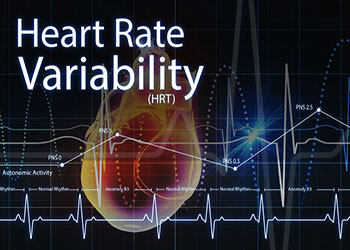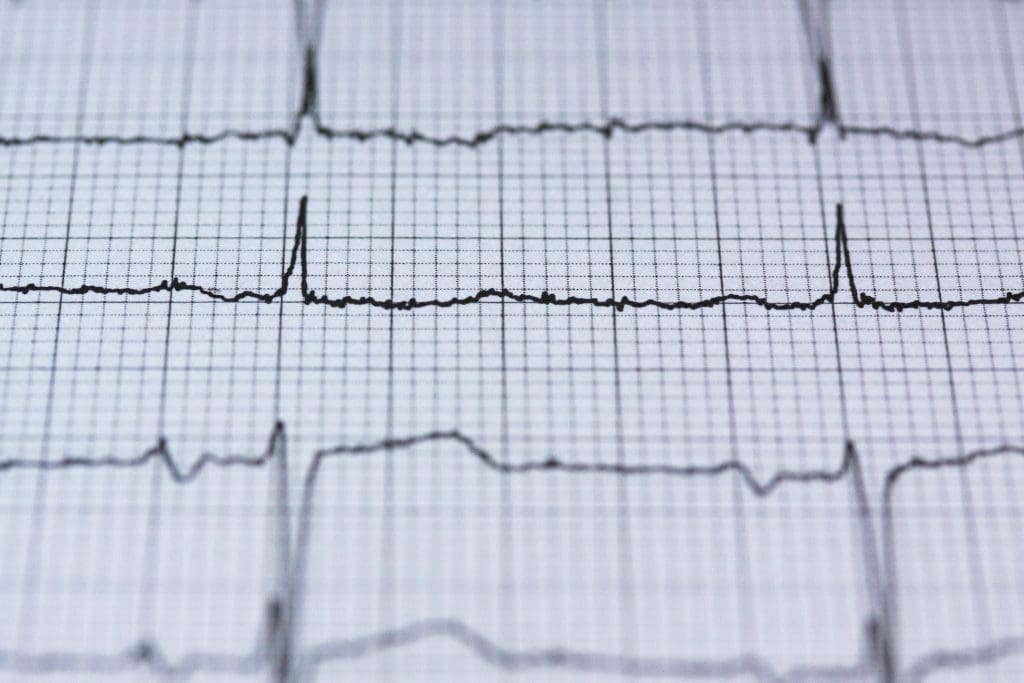

Heart Rate Variability (HRV), or the beat-to-beat alterations in heart rate, is an accurate and reliable reflection of the many physiological factors modulating the normal rhythm of the heart. HRV provides a powerful means of observing the interplay between the sympathetic and parasympathetic autonomic nervous systems (ANS).
The nervous system controls all the other systems of the body, including: organ function, blood pressure, blood sugar, digestive system, immune system, metabolic system, respiratory system and the hormonal system.
Central Nervous System (CNS) – is comprised of the brain and spinal cord. It coordinates the activities of all parts of the body.
Peripheral Nervous System (PNS) – connects the Central Nervous System (CNS) to the organs and limbs.
The Autonomic Nervous System (ANS) – is made up of the Sympathetic and Parasympathetic nervous systems.
The Parasympathetic Nervous System (PNS) – functions similarly to the brakes in a car. The functions of the Parasympathetic Nervous System are summarized by the phrase “rest and repose” or “rest and digest.”
The Sympathetic Nervous System (SNS) – is like the gas pedal in a car. The sympathetic division typically functions in actions requiring quick responses – a “fight or flight” response.
The Non-adrenergic and Non-cholinergic Nervous System – uses nitric oxide as a neurotransmitter have been found to be integral in autonomic function, particularly in the gut and the lungs.
Autonomic Activity – Represents the power or strength of the ANS. The higher your Autonomic Activity is, the healthier you are and the higher your coping ability is to handle stress. Autonomic Balance – Represents the balance between the SNS (Sympathetic Nerve System) and the PNS (Parasympathetic Nerve System) which is controlled by the ANS. An unbalanced ANS can lead to physical problems and disease. Cartesian system of SNS/PNS axes – To the right of the point of Autonomic Balance (PNS > or = 0) represent basically healthy people, while those to the left (PNS < 0) mostly represent temporarily dysfunctional or chronically sick people.

1 PNS prevalence with the average level of SNS activity:
This category represents PNS dominance. It is usually observed when a patient is resting or during the first stage of sleep (specifically, dreamless sleep). In the second stage of sleep, SNS activity is generally increased, at times markedly so. This category is further subdivided into four subcategories, depending on the state of PNS (slight, moderate, significant, sharp). This category is somewhat limited, since it can only be observed in patients with strictly median values of SNS activity.
2 Increase in PNS and SNS activities:
This category is subdivided into sixteen different combinations of PNS/SNS activity. It is characteristic of mostly healthy subjects. One distinctive area in this category represents what might be called the “high sympatho-adrenergic” state corresponding to a significant increase in SNS (points [10,10], [10,50], [50,10], [50,50]. A person reaches this state when he/she experiences a major energy boost (i.e., a sharp SNS increase). The “high sympatho-adrenergic” state is characterized by a sudden adrenaline surge similar to what an athlete feels before a competition or a tiger before a jump. There is an interesting correlation between our results and the popular “Theory of Stress” by Selye. According to this theory, stress could be subdivided into 2 categories: 1) stress as a positive idea, and 2) distress as a negative idea.
Categories 1 through 3 represent basically healthy persons, but we have to keep in mind that healthy people may have two different physiological states. One state has a low level of sympathetic activity and the other has a significant increase in sympathetic activity. Both states are distinguished by an increase in parasympathetic activity. In Selye’s stress theory, an increase in PNS and a significant increase in SNS reflect “positive” stress while a decrease in PNS and a significant increase in SNS reflect distress. Condition of a healthy person with a significant increase in SNS and an increase in PNS (our “high sympatho-adrenergic” state) thus corresponds to Selye’s idea of “positive” stress.
3 SNS Prevalence:
This category represents an increase in SNS combined with a median value of PNS. From the physiological standpoint, this category represents a transitional stage between the second and fourth categories.
4 PNS decrease with SNS increase:
This category can apply to both clinically sick and clinically healthy individuals (defined as those not requiring medical intervention). However, the use of the term “healthy” is not always appropriate since functional imbalance from stress, physical exhaustion, nervous tension, infection, intoxication (including drugs and alcohol), exacerbation of chronic conditions, and many other causes may still be present. In such cases a decrease in PNS due to depressed PNS nerve centers can be observed, along with a simultaneous Sympathetic activation, which is triggered by the struggle of the nervous system to balance itself. When Sympathetic activation is high (points: [0.1,10], [0.1,50], [0.05,10] [0.05,50]), a person reaches an “acute” state characteristic of an acute illness or extreme stress/dysfunction. The “acute” section of Category 4 with a decrease in PNS and a significant increase in SNS clearly corresponds to Selye’s idea of distress as a “negative stress”
5 PNS decrease with average level of SNS:
This category, like the third, is transitional. Everything that pertains to the fourth category can be related to it, but here, SNS activity is within median values. This means that stress, or nervous overload is unlikely. This category may often reflect a depression in the receptor system of PNS, indicating the possibility of chronic pathology.
6 SNS and PNS decrease:
The sixth category, especially beyond the point 0.1 on either axis, reflects a general involuntary degeneration of both SNS and PNS nervous centers. The majority of cases found in this category are either elderly patients or those with diseases causing a significant decrease in the sensitivity of the entire receptor system along with partial degeneration of nervous centers. Examples are the elderly people, patients suffering from cancer or any other disease causing similar expression of ANS centers. Point [0.5,0.5] of this category is an exception to this. It represents an nsignificant, general decrease in ANS and approximates the point of Autonomic Balance. It can be interpreted as a border line value of Autonomic Balance. Points [0.5,0.7], [0.5,0.1], [0.5,0.05] are usually, though not exclusively, found in patients with hyperkalemia or excessive levels of potassium ions, which alter the usual polarized state of the cardiac muscle fibers leading to a decrease in the rate and force of contractions.
7 Autonomic Balance:
It is a category, even though formally it is only a point, and all other points in its vicinity that belong to the other eight categories can be interpreted as borderline values of the Autonomic Balance. The central point is circled in red; the extended “Autonomic Balance” area is marked with a red dotted line.
8 SNS decrease with average level of PNS:
This category, like the third and fifth, is transitional. Everything that pertains to the sixth and ninth categories can be related to it, but here, PNS activity is within median values.
9 Increase in PNS with decrease in SNS:
The ninth category is rather unusual because normally an increase in PNS is accompanied by an increase in SNS. This rare condition is found in water polo athletes, long-distance runners, navy seals and persons with special heart training for deep-sea diving.
Sympathetic dystonia:
This may be a sign of accelerated aging, chronic mental fatigue, overwork, lack of sleep or possibly the presence of any chronic health condition causing a decreased regulatory function of the sympathetic nervous system. If similar results appear 3 or more times in a row, it is recommended that one should have a thorough health checkup. Maintaining a healthy lifestyle may help improve the functioning of the autonomic nervous system.
Relaxation response:
This may be a sign of achieving a mental/physical restful condition and healthy relaxation. If similar results appear 3 or more times in a row and there is no information about any special training skills, it is recommended to perform a thorough health check up. Establishing and maintaining a healthy life style may help to improve the autonomic function.
Autonomic dystonia:
This is likely a sign of an accelerated aging process, physical or mental fatigue, chronic stress, or the presence of a chronic health condition associated with depressed regulatory function of the autonomic nervous system. If similar results appear 3 or more times in a row, it is recommended that one should have a thorough health checkup. Maintaining a healthy lifestyle may help improve the functioning of the autonomic nervous system.
Balanced autonomic normotonia:
(Optimal Balance) This is a sign of optimum performance in the regulatory function of the autonomic nervous system Total autonomic hypertonia: (High Energy Balance) This is a sign of a high level of performance in the regulatory function of the autonomic nervous system, which is typical for active healthy individuals, athletes and other trained people. If similar results appear 3 or more times in a row, it is a sign of good health. Maintaining a healthy lifestyle may help to keep the autonomic nervous system functioning at an optimal level.
Vagal dystonia:
This may be a sign of physical or mental fatigue, chronic stress, possibly the presence of a chronic health condition causing a decrease in the regulatory function of the parasympathetic nervous system. If similar results appear 3 or more times in a row, it is recommended that one should have a thorough health checkup. Maintaining a healthy lifestyle may help improve the functioning of the autonomic nervous system.
Stress response:
This may be a sign of physical or mental stress or the presence of any acute health issue causing an increase in the function of the sympathetic nervous system. If similar results appear 3 or more times in a row, it is recommended that one should have a thorough health checkup. Maintaining a healthy lifestyle may help improve the functioning of the autonomic nervous system.
Tachogram:
The bumpier the red section the better your heart if functioning.
Stress Assessment: Presents an assessment of the accumulated physical and mental stress; these two types of stress are used to assess the general stress levels present in an individual.
Mental Stress Index:
Represents the body’s adaptability to internal and external stress that are placed on the body every day. Mental Stress Index indicates the function of the ANS. If your stress resistance is low it can led to physical problems and disease. This represents the level of stress your body is experiencing at the present time.
Physical Stress Index:
This represents the fatigue or activity of the body on a cellular level.
Watch Dr. Golding talk on Integrative and Anti-Aging Medicine.
Sign up for our newsletter to find out more about the exciting world of integrative medicine
